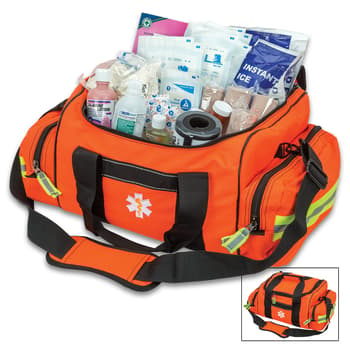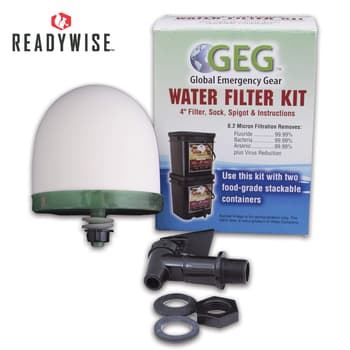Will You Survive A Flood?

By Adelia Ladson
Hurricanes are home and life-threatening when they're happening, especially, on the coast but it's the flooding afterwards, that can affect inland regions, that are the most underestimated. In areas that are prone to flooding, after the sound and the fury of the hurricane passes, the rise of lakes and rivers along with storm surge can become a significant disaster. Are you prepared? Do you know what to do? Will you survive a flood?
What Causes Inland Flooding?
There are a couple of factors that contribute to flooding in inland areas during a hurricane. Obviously, first and foremost, the massive amounts of rain itself, in a short period of time, causes flash flooding. But when a storm stalls over an area that usually doesn't see a lot of rain and has drainage systems not equipped to handle massive amounts of water or are, frankly, antiquated in the first place, you also have flooding. Rainfall that may not seem significant, at first, can also contribute to rivers and other bodies of water overflowing their banks, flooding a low-lying area. Although, storm surge mostly affects coastal regions, it can also cause flooding, inland, by pushing water into already inundated rivers as the sea floods the coast.
What Are The Dangers Of Flooding
The first thing is to understand to your very core that water is a very destructive force. It will move and eat anything in its path. There is nowhere, in its path, that you are safe from it and the possibility of dying a horrible death by drowning. You will be swept away in your car if you try to outrun it and there's a good possibility that your home won't stand against it. It only takes about two feet of moving water to sweep a vehicle away. Most flood fatalities are caused by folks trying to drive through flood waters. When waters rise and everything is carried with it, you don't know what is going to be underneath the surface of the water, which poses its own dangers like venomous snakes and sharp objects, along with, downed power lines, sewage and toxic chemicals that you don't need to come in contact with. This makes flood waters treacherous, even if they are still. Most community infrastructures just aren’t ready for and can’t take the amount of water a flood brings. Sewer systems are overwhelmed, roads are flooded, and bridges can collapse, along with utility poles. Your local fire station or public works department may sustain damage that prevents them from being able to work up to their full potential. So, when you take all of the public services and day-to-day services into consideration, the devastation caused by flooding can seem apocalyptic.
How Do I Prepare?
You have to accept that your community’s basic infrastructure may be damaged and then, take some responsibility for you and your family’s own well-being. You can do this by arming yourself with knowledge ahead of time. First of all, contact your emergency management office or planning and zoning office to see if you live in an area that could be at risk for flooding. Do this today! Even if it never happens, you need to know if it could happen. Next, find out the elevation of your property compared to any nearby bodies of water or dams. This will allow you to judge if any forecasted flood levels would pose a threat to your home. If you know that you are in a low-lying area or live by a body of water that could overflow its banks, you need to get you and your family to safety. If they tell you to evacuate, don’t wait! Just do it! The flood waters may never reach your house and flood it but there is no guarantee. Just go ahead and make arrangements to stay somewhere else for a few days. Do you have a relative who lives on higher ground or maybe another area where the hurricane or storm is not going to affect? If you have time, you can sandbag your house to try and minimize damage but please don’t trust the lives of yourself and your family to them. Leave the area before it gets to that critical rescue stage!
To be completely armed with knowledge ahead of time, you must have a portable weather radio that reliably broadcasts, the NOAA (National Oceanic and Atmospheric Administration) alerts. This will give you real-time updates on what is heading your way, plus, if you are in the process of evacuation, you can still stay informed wherever you are. A radio that fits the bill and is very user-friendly, the Uniden Base And Mobile Scanner monitors 300 channels including the NOAA channels at an impossibly fast 100 channels per second scanning speed. Also, included are bands on which you can listen to area law enforcement, EMS/ambulance, fire, public utilities and amateur radio. Uniden's own innovative "Close Call" radio frequency capture technology instantly tunes your scanner to signals from nearby transmitters. The scanner can be used both at home and on-the-go with three power options including an AC adapter, DC power cable and an automotive outlet plug. A weather radio will let you know if any flash floods have been reported in your area. It's important to remember that a "watch" issued means the weather conditions are favorable for a dangerous weather event within the next 12 to 36 hours and a “warning” issued means the dangerous weather event is occurring or will be in the next 30 minutes to an hour.
Along with being armed with knowledge, there's a certain amount of preparation that you need to do, as well. You must have an emergency supply kit ready in your home that can be used whether you are staying in your home or evacuating from your home. The contents of the kit needs to be kept up-to-date and everyone in your household should know where it's located. Get a sturdy pack or bag that's a nice, big size but also easy to just grab-and-go. Drop in a first aid kit, one gallon of water per person for at least three days, a three-day supply of food for your family, a flashlight and extra batteries, a signal whistle, garbage bags, duct tape, plastic sheeting, moist towelettes (think personal sanitation) and a wrench to turn off the utilities. These are the items that FEMA says that you should have in your emergency kit. Add more items that you think that you might need because, after all, it will be you and your family's specific needs that have to be met during a flood emergency.
What Do I Do If I'm Caught In A Flood
If you are caught in a flash flood, the key to survival is to get as high up as possible to get away from the fast-moving water. Seems like a no-brainer, right? But somehow statistics show that it’s not sinking in. Don’t ever try to drive, walk or even swim through flood waters. They will wash you away no matter how shallow they seem or how good of a swimmer you think you are. Rushing water is an unforgiving and unstoppable force. If water has chased you to your roof or second floor, this is where having a signal whistle can help alert rescue teams that you are there. I would also add to your emergency kit a large red towel as this will draw attention to you when you wave it in the air. If it's nighttime, you can obviously use your flashlight. I would also include in the emergency kit a good length of rope that can be used as a lifeline for you and your family members to keep you secured to the roof and each other, if it comes to that.
Afterwards, when the flood waters are still high, even if your home isn't flooded, you can be in trouble because of the loss of power and water services. Since, really, having water is a primary must for survival (dehydration can happen quickly), having some kind of water filtration system in place is your best bet. Then, you can source your water from anywhere, even your front yard or street, and make it safe to drink. Once again, make sure that you and your family members only venture outside if absolutely necessary. Like I said above, the standing water in itself is dangerous because of what it contains and never, ever get in your car and try to maneuver through them.



